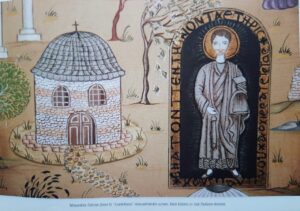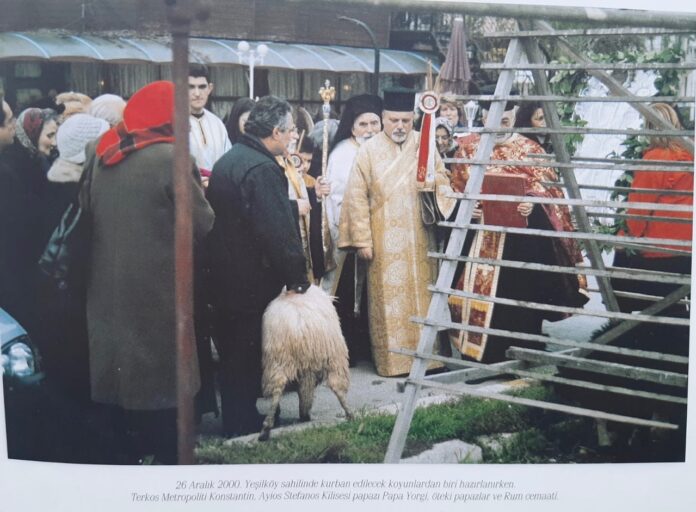Sacrifices are still being sacrificed in the church in Yeşilköy for years. The sacrificial sheeps would gather in the garden. After the morning prayer, there were always the old people of Yeşilköy who also came from Greece, and they still do. After that, the big icon was lifted and carried by a young lady and a young man. They go up to the seaside. And the sacrificial sheeps were slaughtered by the sea. There aren’t many Greeks here anyway. They give it to a few poor families. The number of slaughtered sheep is 10-15, the last time since this last 2-3 years. Apart from that, meat is already given to the Hospice.
I have been going for a long time. It is famous for these ceremonies and it is the only church in Turkey where sacrifices were made. It’s also to honor sailors while the saint’s bones are being transported. During the storm for 10-12 days, sailors always feed mutton. This sacrifice ceremony is held in his memory. I wrote about this at length in the Yeşilköy book, and that sacrifice ceremony has a name.
Feast of Sacrifice of Agios Stefanos Church: THISIAS. Yeşilköy Ayios Stefanos Greek church is one of the rare churches that practice and maintain the ritual of sacrificing among all Orthodox churches that have been existing in Turkey, even in Greece and other countries. For centuries, every year on December 26, prayers are said in the name of St. Stefanos by gathering in the church, and then going down to the beach, pre-purchased sheep are sacrificed and their meat is distributed to poor and needy citizens.
The roots of this tradition, called Thisias, which has been continued in Yeşilköy from the Byzantine period to the present day, is based on the story of St.Stephanos. With a big storm, the ship docked at today’s Yeşilköy coast, and when the storm got worse and lasted for days, the bones of the saint were taken to the beach and taken under protection under a tent, and the villagers slaughtered their sheep and gave their meat to the sailors so that the ship’s crew would not starve.
After the end of the storm, the bones of St.Stefanos were loaded back on the ship and transported to Italy without any accident. Here, after this event, the feast of sacrificing sheep, which has become a tradition, has been repeated every year and has survived to the present day.
For this holy month on December 26, the sheep purchased in advance are brought to the garden of the church, after the prayers read inside, the large silver-framed icon of Ayios Stefanos decorated with leaves is carried out by a man and a woman. Terkos metropolitan and priests come from Mirasyedi street towards the coast, and the sheep are sacrificed one by one on the land, and their meat is sent to be distributed to poor and needy citizens.
Among all Orthodox churches, this traditional feast peculiar to the Yesilkoy Greek church is one of the most beautiful examples of the richness of folklore and religious culture in a district that has been carried over the centuries.
Thisias (sacrifice) Feast in the Yeşilköy Greek church , which is continued every year as in the past, is celebrated with a ritual performed by a small number of Greek community from Yeşilköy and other districts, and then the previously purchased sheep are sacrificed by going down to the beach. As Sofia Benlisoy , one of the former residents of Yeşilköy, tells, the meat of animals sacrificed in the past was sent to the orphanage on the big island, and some of them were sent to the police station in Yeşilköy and the fire department.
Meri Shehab, born in 1935, tells:
My father, Monsieur Röne, after whom the park he ran for many years was named, was a benevolent person who liked to do good. He took care of the poor and the needy and helped them without being noticed. In the feast of Thisias held in the Greek church, the person who sacrificed the most sheep almost every year was my father. He was also among the members of the church board of trustees.
Agios Stefanos Greek Church
As it is known and stated in historical sources, Ayios Stefanos Greek Church, located between Mirasyedi Street and Kalemkar Street , is the oldest place of worship in Yeşilköy. In the fourth century, during the reign of the Byzantine emperor Constantine the Great, the bones of St.Stephanos were found, albeit for a very short time; The fact that it was taken under protection near the beach and that this small fishing village was consecrated by taking the name of the saint in question after it was sent to the Vatican, and a church was built in his name right after it (probably, there was also a small monastery next to it). It forms the first and oldest church.
It is certain that the first church built here belongs to the early Byzantine period. According to the information given by the researcher Zaven Acemyan from Yeşilköy, based on the information he obtained from various institutional sources, the first church built here should be dated to the fourth century. In addition, a few small pieces of St.Stephanos’ bones were placed in a golden enclosure on the foundation believed to have been under the present church when the first church was being built . Although not much remains of this first place of worship, the marble sarcophagus from the early Byzantine period, which was wounded in the garden of today’s church, on the side facing the sea, justifies this thesis.
Unfortunately, it is not known who the sarcophagus in question belongs to in written texts and sources. However, due to its splendid location, it can be thought that it belonged to an important clergyman or an individual from the imperial family and that it dates from the period of the first church built in Ayestefanos. The first church, which we can define as a simple structure in the course of time, and other examples built in much later periods, were the target of some devastating events such as earthquakes, fires, and enemy raids. The church today was built as a church, and it was inaugurated by Patriarch Mektios on September 9, 1845.
As a matter of fact, the exterior architectural features of the Surp Stepanos Armenian church and Ayios Stefanos churches, which were built by Boğos Dadyan Bey in the same period, have the same elements. Most likely, both churches were made by the same architect. The church of Ayios Stefanos, which was built in 1845 and has survived to the present day, is a masonry structure with tile masonry on four walls. In the interior of the church, which is illuminated by ten windows, the right and left naves are separated from the central nave by a total of eight arched columns.
The iconostasis wall in the apse of the church, the Metropolitan seat called Thronos and the seats where the clergy sit are made of wood and decorated in a very rich way typical of Orthodox churches. In particular, the gilded reliefs on the iconostasis are quite dazzling. In front of the iconostasis with two copper candlesticks, there are silver-plated icons of Jesus and the saints. In addition, there are other icons on the walls of the church, including Ayios Stefanos.























